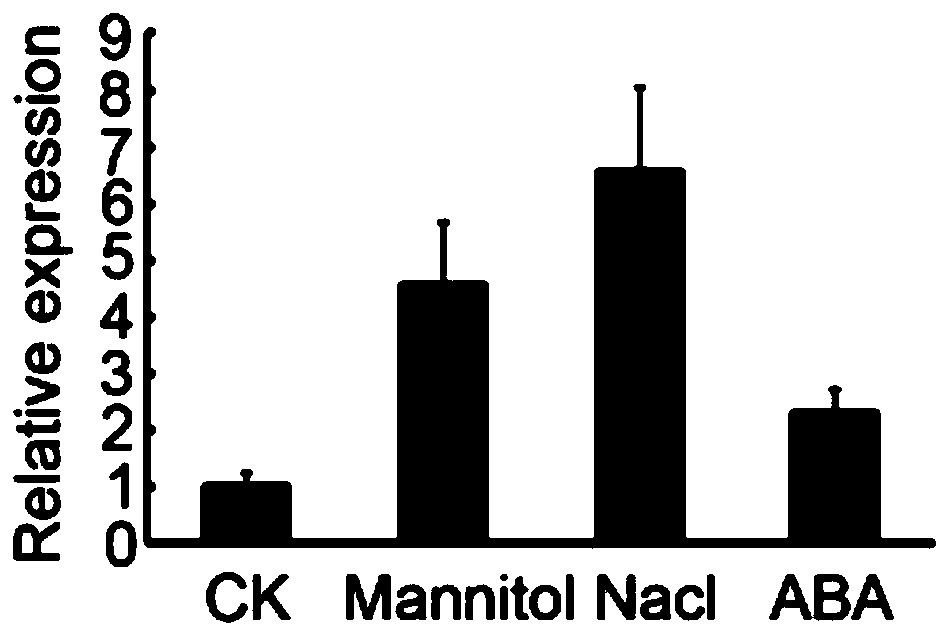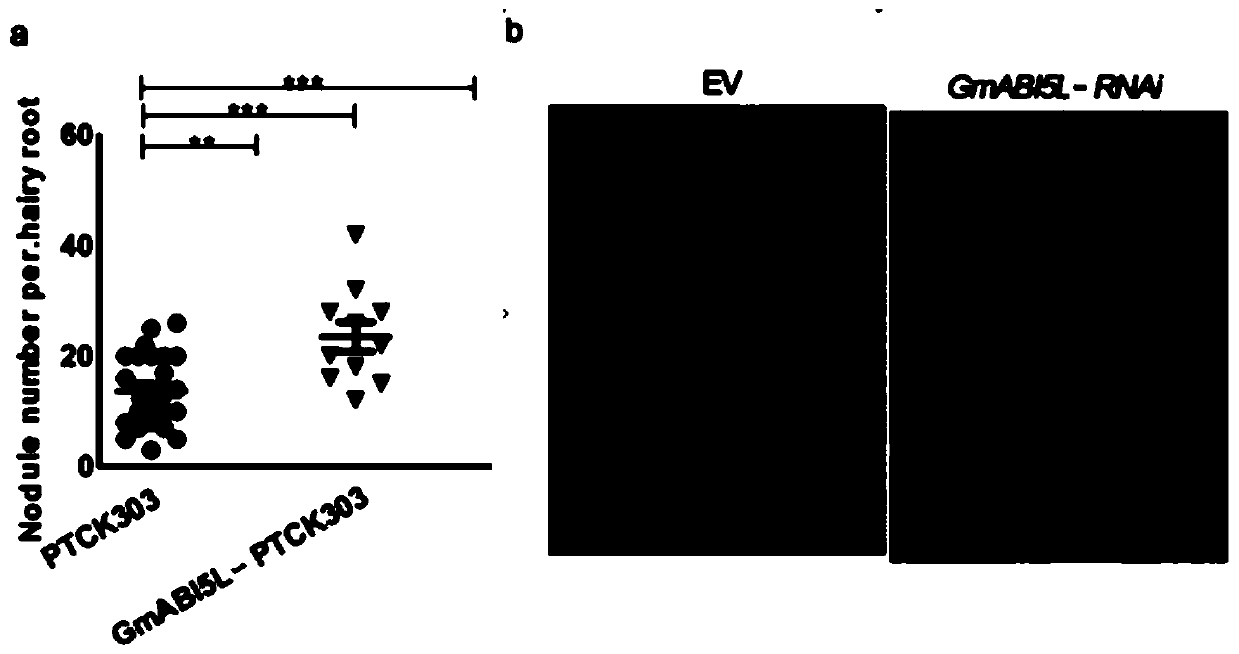Method for cultivating highly noduled transgenic plants based on RNA interference technology
A technology of transgenic plants and RNA interference, applied in the field of genetic engineering, can solve the problems that have not yet been seen
- Summary
- Abstract
- Description
- Claims
- Application Information
AI Technical Summary
Problems solved by technology
Method used
Image
Examples
Embodiment 1
[0034] Example 1. Analysis of the expression pattern of GmABI5L gene in response to ABA, drought and salt treatment.
[0035] 1) Material acquisition: The material used in the experiment is Williams 82 (abbreviated as W82); the material is carried out according to the following process: soybean seeds are sterilized with 70% alcohol for 30 seconds, germinated in B5 medium, 16h light / 8h dark, light intensity 7000LUX, temperature 26℃, relative humidity 70%. After 5 days, the following methods were used: ABA treatment, 0μM ABA or 50μM ABA treatment for 6 hours; drought treatment: 200mM mannitol treatment for 6 hours; salt treatment: 100mM NaCl treatment for 6 hours. Pour out the vermiculite, and sample the site from 2cm below the rhizome junction to the root tip.
[0036] 2) Isolation of mRNA: the Trizol method is used to extract total soybean RNA. ① Put the tissue into the grinding and grind it with liquid nitrogen 3 times, add 0.1-0.2g of the ground tissue to a 1mL centrifuge tube a...
Embodiment 2
[0042] Example 2. Analysis of the expression pattern of GmABI5L gene in response to Rhizobium infection.
[0043] 1) Material acquisition: The material used in the experiment is Williams 82 (abbreviated as W82); the material is carried out according to the following process: Soybean seeds are sterilized with 70% sprinkling for 30 seconds, and sown in a vermiculite matrix soaked in a low nitrogen nutrient solution. Cultivate in the culture room, 16h light / 8h dark, light intensity 7000LUX, temperature 26℃, relative humidity 70%. 9 days after germination, the soybeans are inoculated with rhizobia, and each strain is inoculated with slow-growing rhizobia USDA110 bacterial solution 600 =0.08) 30 mL, and take the soybean roots at 0, 14, 21 and 28 days after inoculation.
[0044] 2) Isolation of mRNA: the Trizol method is used to extract total soybean RNA. ① Put the tissue into the grinding and grind it with liquid nitrogen 3 times, add 0.1-0.2g of the ground tissue to a 1mL centrifuge tu...
Embodiment 3
[0050] Example 3. Using RNAi vector to down-regulate and express GmABI5L gene to cultivate transgenic soybean with high nodulation and nitrogen fixation ability.
[0051] 1) Construct a recombinant expression vector.
[0052] (1) Cloning of GmABI5L gene fragment:
[0053] According to the coding sequence of GmABI5L (SEQ ID NO:1), a primer pair was designed for RNAi vector construction. According to the multiple cloning site on the vector pTCK303, the primer ends were introduced with KpnI, SpeI, BamHI, and SacI restriction sites; The cDNA of the sequenced variety W82 was used as a template for PCR, and the amplification primer sequence was:
[0054] Forward primer: GGGGTACCAC TAGTTGGGAA GACACCAGCA AATAA (SEQ ID NO: 2);
[0055] Reverse primer: CGGGATCCGA GCTCCTCTCA CAACACCAGC TCTCAC (SEQ ID NO: 3);
[0056] The amplification procedure is: 95°C 5min; 95°C 30sec, 56°C 30sec, 68°C 2min, 30 cycles; 72°C 70sec;
[0057] The PCR amplified product was subjected to 1% agarose gel electrophoresis,...
PUM
 Login to View More
Login to View More Abstract
Description
Claims
Application Information
 Login to View More
Login to View More - R&D
- Intellectual Property
- Life Sciences
- Materials
- Tech Scout
- Unparalleled Data Quality
- Higher Quality Content
- 60% Fewer Hallucinations
Browse by: Latest US Patents, China's latest patents, Technical Efficacy Thesaurus, Application Domain, Technology Topic, Popular Technical Reports.
© 2025 PatSnap. All rights reserved.Legal|Privacy policy|Modern Slavery Act Transparency Statement|Sitemap|About US| Contact US: help@patsnap.com



